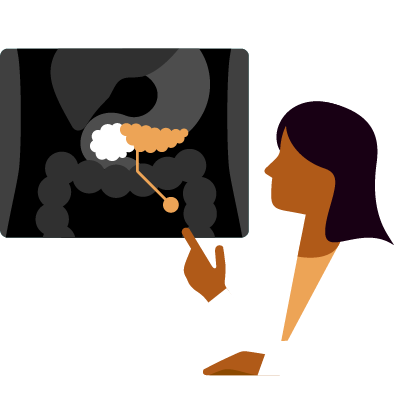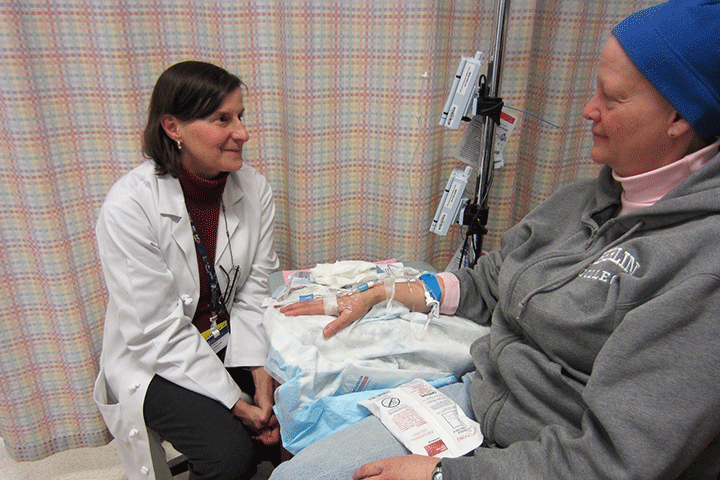Chemotherapy in Comfort

Many of the standard chemotherapy drugs for pancreatic cancer are given as infusions at a treatment center.
This means that when you receive chemotherapy, it’s a safe bet you’ll be stuck in one place, sometimes for several hours. To make the most of their time in the chair, many cancer patients put together a sort of pamper or care package to occupy themselves during infusions.
“If you’re going to be in the chair for several hours, the trick is to transform your surroundings into a comforting space,” says Heather Hannon, Oncology Nurse Practitioner at Women’s Cancer & Wellness Institute (Richmond, Virginia). To ensure you have an easy infusion day, dress in comfortable clothing. Pancreatic cancer patients receive chemotherapy through a peripherally inserted central catheter (PICC line) or a port, so wearing a button-down shirt or a blouse with a zipper in the front is ideal. “The idea is to make your infusion time as normal and comfortable as possible,” Hannon adds.
Chemotherapy Essentials
While every chemotherapy regimen is unique, many pancreatic cancer patients benefit from bringing the following things with them or in their comfort care bag on treatment days:
- Company: Depending which type of chemotherapy you’re getting, you may be sitting in the chair for a long time. Having someone you love sitting beside you can make the time pass more quickly. Most infusion centers limit the number of guests you can bring with you, so be sure to check in advance. For longer days, you can space out your visitors. “Maybe your mom comes for the first part of the day and your best friend comes toward the end,” suggests Hannon.
- Blankets, gloves, and cozy socks: Certain chemotherapy regimens, particularly those that include oxaliplatin, can cause temperature sensitivity. To stay warm and cozy, bring gloves, socks, and plush blankets. “Some infusion centers even have blanket warmers to help compensate for cold sensitivity,” Hannon notes.
- A water bottle: Chemotherapy can be dehydrating. “Your mouth may feel dry and you may notice that your skin and lips feel dry, too,” explains Hannon. Replenishing lost fluids with water not only helps wet a dry mouth, but it also helps your body flush out toxins after treatment.
- Moisturizing aids: It’s a good idea to have moisturizing lotion on hand to soothe dry, chapped skin. Lips also dry out, so keep lip balm in your bag, too.
- Something to put in your mouth: Hard candies, like Life Savers candies or mints, not only help alleviate dry mouth, they can also obliterate the strange tastes that tend to accompany treatments. Want to do double duty? Choose ginger-flavored candies, lollipops, or chew sticks. Studies show ginger can help reduce chemotherapy-associated nausea and vomiting—and it’s safe for cancer patients.
- Feel-good items: Get creative with the items you bring. “Some patients bring a family picture or a stuffed animal that carries meaning for them,” explains Hannon. “Others bring a string of affirmations that they hang by their chair to encourage good feelings while they’re in the chair.” Another popular item: a soft pillow. Placing a pillow under your legs or neck can help you feel more at home.
- Thoughtful activities: Whether music, books, or a guided meditation app, anything that occupies your mind and makes you feel good at the same time is a win. Some people choose adult coloring books. Other people opt for crosswords or knitting projects. “You might even allow yourself to drift off to sleep for a while,” Hannon says.
- A change of clothing: Some chemotherapy regimens can cause diarrhea. Others are hydrating. In either case, you may have trouble making it to the bathroom in a timely fashion. While most centers have sanitary pads in the restrooms, it’s a good idea to come to treatments prepared with backup clothes and underwear. You can leave these items in the car, but it’s nice to have them on hand if necessary.
Unwelcome Items
Not every item you would like to have on hand is allowed in a chemotherapy or infusion center. Items to steer clear of include:
- Flowers and plants: Live plants and cut flowers carry germs, which may pose a threat to people who have weakened immune systems.
- Aromatherapy: Your senses take a hit during treatment. Smells and tastes you once enjoyed may become intolerable. More important, patients who are receiving infusions near you may not enjoy the same scents you do.
- Candles: While burning candles during infusions is prohibited (it’s a fire hazard), some centers allow battery-operated tea lights to create a peaceful glow during treatments.
- Pets: Unfortunately, if your favorite pet isn’t a therapy animal, he/she has to stay at home.
Maximizing Your Treatment Time
Receiving chemotherapy for several hours can be productive or mindless. You get to decide how you would like to pass the time. Maybe you want to get lost in a novel or stream the latest blockbuster through your headphones. But if the idea of sitting in a chair makes you feel antsy or scattered, talk to the nursing staff.
“In many cases, a nurse navigator can connect you with a dietitian, social worker, or other health professional who can provide education and information while you’re getting chemotherapy,” Hannon says. These visits not only occupy your time while you’re sitting in the chair, they also help you sidestep a separate visit.





